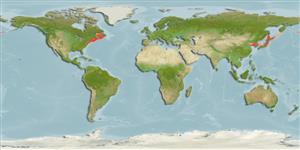Common names from other countries
Environment: milieu / climate zone / depth range / distribution range
Écologie
; profondeur 0 - 300 m (Ref. 83435), usually 30 - 91 m (Ref. 83435). Temperate, preferred 9°C (Ref. 107945); 52°N - 35°N, 75°E - 56°W (Ref. 83435)
Distribution
Pays | Zones FAO | Écosystèmes | Occurrences | Introductions
Western Central Pacific and Northwest Atlantic: Palau, Canada to USA.
Length at first maturity / Taille / Poids / Âge
Maturity: Lm ? range ? - ? cm Max length : 20.0 cm TL mâle / non sexé; (Ref. 7726); âge max. reporté: 12 années (Ref. 8702)
Large epibenthic bivalve found along the continental shelf (Ref. 121934). Semi-mobile. Opportunistic filter feeder, utilizing both pelagic and benthic organisms as food (Ref. 106925),
Life cycle and mating behavior
Maturité | Reproduction | Frai | Œufs | Fécondité | Larves
Members of the class Bivalvia are mostly gonochoric, some are protandric hermaphrodites. Life cycle: Embryos develop into free-swimming trocophore larvae, succeeded by the bivalve veliger, resembling a miniature clam.
Harvey-Clark, C. 1997. (Ref. 7726)
Statut dans la liste rouge de l'IUCN (Ref. 130435)
statut CITES (Ref. 108899)
Not Evaluated
Not Evaluated
Utilisations par l'homme
Pêcheries: commercial
FAO - pêcheries: landings, species profile | FishSource | Sea Around Us
Outils
Sources Internet
Estimates based on models
Preferred temperature
(Ref.
115969): 1.9 - 11.7, mean 8.5 (based on 153 cells).
Résilience
Milieu, temps minimum de doublement de population : 1,4 à 4,4 années (K=0.16-0.38; tmax=12).
Prior r = 0.78, 95% CL = 0.51 - 1.17, Based on 2 full stock assessments.
Vulnérabilité
Moderate vulnerability (45 of 100).
